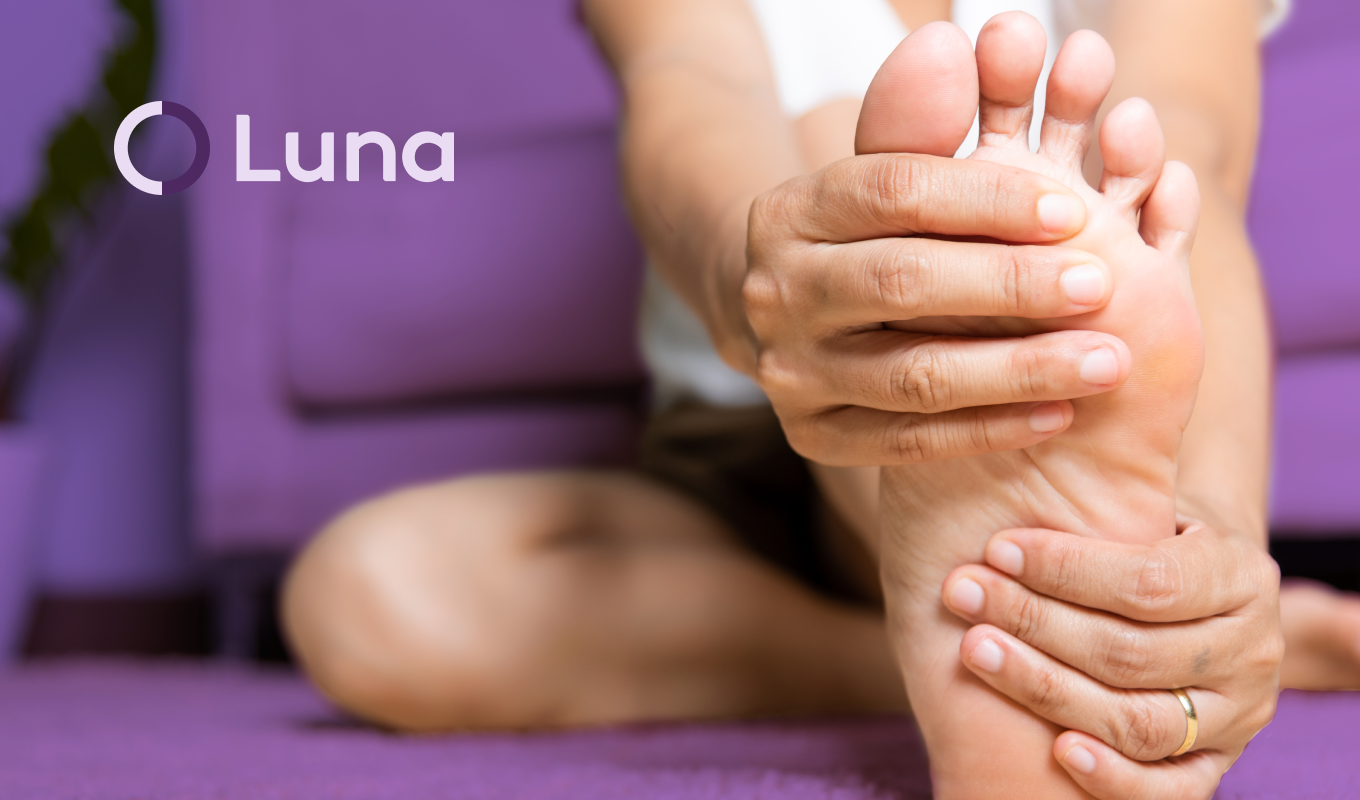The Fastest Way to Cure Plantar Fascitiis

Plantar fasciitis is a common condition that affects one in 10 people over their lifetime, and two million people every single year. Your feet and ankles carry the weight of responsibility every day—that’s you! They endure your whole body weight to keep you upright and going about your day. When you experience chronic pain in your heel, it can be debilitating, making daily activities unbearable.
Main Causes of Plantar Fasciitis Pain
With plantar fasciitis, heel pain is commonly felt early in the morning and naturally goes away. However, it often returns after a long period of standing or inactivity when you put extra weight on your feet. Over time, the tissue that connects your heel to your toes (plantar fascia) loses its elasticity and becomes inflamed. When there’s inflammation, you’ll feel a sharp pain.
Anyone can suffer from plantar fasciitis, but according to the Mayo Clinic, it’s more common among the ages of 40 - 60. Runners and those who are on their feet all day are at a higher risk of developing symptoms.
Additional causes of plantar fasciitis and put extra stress on your heel include:
-
Long-distance running
-
High-arched or flat feet
-
Exercising on a hard surface
-
A job that requires standing for long periods of time
-
Obesity
Even the shape and size of your shoes can lead to this condition, so be sure to wear shoes with good heel and arch support.
Curing Plantar Fasciitis in One Week

Nothing is more frustrating than being sidelined by pain —especially when it's caused by plantar fasciitis. So, is it possible to cure your heel pain and get back to the activities you love so quickly? Let’s take a look at how to cure plantar fasciitis in one week:
-
Rest and Ice Therapy — Allow your feet to rest as much as possible and avoid activities that exacerbate the pain, such as high-impact activities. Apply ice packs to the affected area for 15-20 minutes several times a day to reduce inflammation and soothe the pain.
-
Stretching and Strengthening Exercises — Perform regular stretching exercises to alleviate tension in the plantar fascia. Calf stretches, toe curls, and heel raises can help improve flexibility and strengthen the surrounding muscles. It’s important to consult a physical therapist for guidance on the most effective exercises and to be aware of ones to avoid that could slow down the healing process.
-
Proper Footwear — Wearing supportive shoes with good arch support can alleviate pressure on the plantar fascia. Opt for shoes that offer cushioning and shock absorption. Avoid old, worn-out shoes with minimal arch support, as they can worsen the condition.
-
Stretch While Asleep — While you sleep, the period of inactivity causes the area around the plantar fascia to stiffen. Using a night splint helps reduce morning pain by keeping your foot in a stretched position while you sleep.
Does Plantar Fasciitis Go Away?
Initial conservative treatments like stretching and reducing stress on the plantar fascia are typically all that’s needed to heal, but you may wonder, does plantar fasciitis go away?
Plantar fasciitis can be a persistent condition — one that you don’t want to hold onto for longer than necessary. This condition has the potential to resolve on its own, but only with time and proper care. Focusing on treatments aimed at reducing inflammation, improving range of motion, and lengthening the tissues will result in significant improvement and a complete resolution of symptoms.
The duration of recovery can vary from person to person, and some patients may require more intervention to find the relief they need. While some experience relief within a few weeks or months, others may find that their symptoms persist for much longer without the right treatment. Consistency and patience are key to achieving long-lasting relief.
While plantar fasciitis has the potential to resolve on its own, it is important to be proactive in managing the condition and seeking appropriate care if symptoms persist — or are more severe. With the right approach, including self-care measures and the guidance of a physical therapist, you’ll experience a successful recovery and enjoy a pain-free future.
The Role of Medical Devices
While physical therapy and low-impact exercises are often the most successful approach, some benefit from additional support from plantar fasciitis medical devices. These tools play a supportive role in managing pain and improving function, often used as one part of a full treatment routine.
Commonly used medical devices for plantar fasciitis:
-
Orthotic Inserts — Specially designed shoe inserts that support the arch of the foot, providing stability and cushioning for your feet while walking or standing.

-
Night Splint — A brace that keeps your foot in a flexed position overnight, stretching the plantar fascia and reducing stiffness and pain in the morning.

-
Compression Socks — Designed to promote blood flow and reduce swelling in the foot, but they may cause discomfort if worn for extended periods of time.

-
Massage Balls and Rollers — Used to massage the bottom of your feet to relieve tension and break up scar tissue.

-
Kinesiology Tape — Applied to the foot in a specific pattern, this tape supports and reduces stress on the plantar fascia, facilitating motion and circulation.

Incorporating these medical devices into your treatment plan will help you on your way to a faster recovery, providing maximum relief.
What to Avoid During the Healing Process
Now that we’ve covered tools and treatments for recovering from your chronic heel pain, we want to talk briefly about what not to do with plantar fasciitis. Some activities can slow down the healing process. By understanding what not to do, you can create an environment for a fast and effective recovery.
Do not ignore the pain. Disregarding your body’s signals and pushing through the pain can lead to increased inflammation and prolonged healing time. Avoid engaging in high-impact activities that put excessive strain on the plantar fascia. Activities like running, jumping, or participating in sports can worsen the symptoms.
Listen to your feet and provide them with the rest they need to recover, but also try to avoid prolonged periods of inactivity. Incorporating gentle stretching and strengthening exercises into your daily routine will help to maintain fitness while minimizing stress on the affected area.
Managing Your Plantar Fasciitis with Physical Therapy
Repetitive stretching and stress on the plantar fascia create small tears over time, so high-impact activities like running or jumping will only make the pain worse. The best—and the fastest—way to recover is through manual physical therapy and low-impact exercises that focus on the Achilles tendon and plantar fascia.
Regular physical therapy treatment will rebuild stability in your ankle and strengthen your tissue along the sole of your foot. But sometimes when life gets in the way, and we get busy, it can be hard to adhere to your course of care. That’s why with Luna patients have access to at-home physical therapy.
PT Treatments with Luna
With access to Luna’s on-demand physical therapy, you’ll get treatment when and where you need it. More one-on-one time with a licensed therapist dedicated to your treatment plan results in more success and better outcomes, improving the overall effectiveness of your therapy and leading to a faster recovery.
Your board-certified physical therapist will work with you to create a customized plan for guided stretching and strengthening exercises. As you improve your flexibility in the arch of your foot along with the muscles and tendons surrounding it, you’ll feel less pain and prevent your plantar fasciitis from coming back.If you have chronic heel pain and are considering physical therapy, find a therapist near you and learn how Luna can help cure your pain and improve your quality of life with physical therapy.
Preventing Future Heel Pain: Your Healing Advocate
As you embark on your journey to heal from plantar fasciitis with the support of physical therapy from Luna, know you are not alone in this process. Our dedicated team of skilled therapists will be by your side, providing compassionate care, evidence-based treatments, and unwavering support throughout your recovery.
By partnering with your physical therapist and being proactive in your approach, you become an active participant in your own healing process. Your commitment to self-care, consistent adherence to treatment recommendations, and monitoring your foot health will contribute to a pain-free recovery. Adopting preventive measures will protect you from future heel pain and pave the way toward a healthy future.
If you have chronic heel pain and are considering physical therapy, find a therapist near you and learn how Luna can help cure your pain and improve your quality of life with physical therapy.
Handpicked Resources for You



